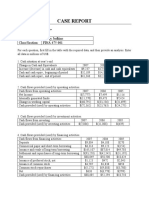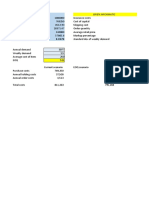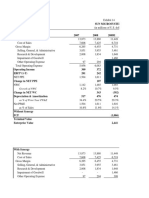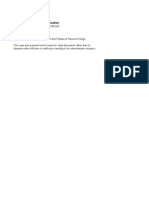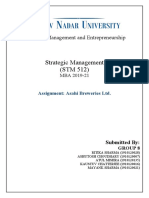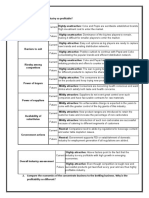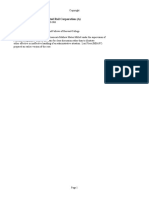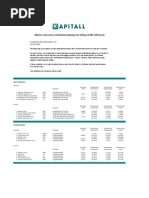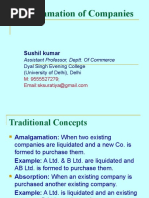Assingment - FM - Chestnut
Assingment - FM - Chestnut
Uploaded by
Chandra Prakash SCopyright:
Available Formats
Assingment - FM - Chestnut
Assingment - FM - Chestnut
Uploaded by
Chandra Prakash SOriginal Title
Copyright
Available Formats
Share this document
Did you find this document useful?
Is this content inappropriate?
Copyright:
Available Formats
Assingment - FM - Chestnut
Assingment - FM - Chestnut
Uploaded by
Chandra Prakash SCopyright:
Available Formats
FINANCIAL MANAGEMENT
ASSINGMENT SUBMISSION
CASE#8 CHESTNUT FOODS-Revision#1
Team members:
S. Chandra Prakash (CGT19010),
M. Manjunathan (CGT19011),
Prashant Sharma (CGT19021),
Shivam Agrawal (CGT19026)
PART A: CASE BACKGROUND:
Chestnut food was founded by Mr. Otto Chest nut in 1877 as a food selling
company. Chestnut foods grew both organically and inorganically over the years
and went public in 1979. By 2013 company was valued at 1.8 Billion Dollars with
annual profit of 130 Million Dollars.
Now Chesnut foods operates in two divisions:
a) Foods Division: Produced fresh, prepackaged and processed foods for retail and
food services. The division achieved an average annual growth rate of 2% during
2010 through 2013. In 2013 food division net operating profit after tax (NOPAT)
and net assets were worth 88 Million dollars and 1.4 billion dollars. For future
return on capital for the division were expected to be 6.3%.
b) Instrument Division: Chestnut Food had developed a strong expertise in food
process instruments over the years as it was using a lot these instruments. In 1991
chestnut purchased Consolidated Automation systems, a medium – sized food
processing instrument equipment company and hence instrument division was born.
Subsequent purchases were done by Chest nut after successful results in Instrument
division. It delivered systems and specialized equipment used in the processing and
packaging of food products. It provided a variety of quality control and automation
services used within the company. Instrument division supplied 20% of its revenue
to food product division. In 2013 instrument division sales has increased by 20%.
The NOPAT was 46 million dollars and net assets were 600 million dollars. The
expected return on capital was expected to be 7.7%.
The company took increasing pride in the high quality of its manufacturing process
and believed it to be an important differentiator among both investors and
consumers.
S. Chandra Prakash (CGT19010), M. Manjunathan (CGT19011), Prashant Sharma
(CGT19021), Shivam Agrawal (CGT19026)
Instrument Division Highlights:
The current hurdle rate set by company for raising any capital is 7%.
PART B: PROBLEMS:
In recent years, chest nut’s shares had failed to keep pace with either the overall
stock market or industry indexes for foods or machinery as shown in Exhibit-1 in
Case. Subsequently company’s credit rating has been downgraded to A- by S&P.
Some attributed this downfall due to increasing competition and changing demand
of the industry. An Analyst mentioned “Chest nut has become vulnerable to a
hostile takeover as a vacant umbrella on a hot beach “.
Hence CFO Brenda Pedersen wants to take steps to reverse this declining trend.
Brenda has proposed two strategic initiatives:
a) 1Billion dollar investment in company growth to expand the instrument division.
b) Adoption of a more progressive corporate identity.
However, Brenda is told that, a business man Van Mur buys a 10% of Chest nut,
seeing that the chest nut share price is depressed, and seeks a seat on the board and
a new management direction. He is recommending that instrument division be sold
off and the company should make focus towards the food division as it is its core
activity. The reason he is recommending for sale may be to get more out of its
investment. Instrument division is growing at an excellent rate and will result in
high benefit for shareholder if it is disposed of now.
Brenda Pederson called all the VPs to discuss the proposal for these two initiatives
and to discuss proposal for different hurdle rates for different divisions. She
believes that both the division have different degree of risk and hence the evaluation
S. Chandra Prakash (CGT19010), M. Manjunathan (CGT19011), Prashant Sharma
(CGT19021), Shivam Agrawal (CGT19026)
of both the divisions cannot be done on the basis of a single hurdle rate. In food
division, the cost of capital is 6.3% while in instrument division it is 7.7 %. The
company’s current hurdle rate is 7% to evaluate any project. VP Meyer also
supported this view and explained all on the basis of the graph shown below .
However there has been no consensus between the management for making
different hurdle rates. For example, VP of instrument division believed that the
hurdle rate of both instrument division and product division should be same.
The issues for which Brenda needs to find solution can be summarized as:
a) To find out whether instrument division was performing well or not as asserted
by Van Mur or Meyer? To correctly evaluate the performance of both the divisions.
b) How to convince VPs and management for different hurdle rate for different
division, which as per Brenda is important to take a correct business decision
regarding investment?
c) How to convince the management to negate the influence of Van Mur on the
company’s management for selling the instrument division.
d) Is her proposal for changing corporate identity of instrument division good? How
to convince the management
e) How to convince management & Van Mur to generate 1Billion dollars for
investment in Instrument division expansion? How to influence the investors to
invest in Chestnut because of the high valued offerings that the instrument division
maintained.
S. Chandra Prakash (CGT19010), M. Manjunathan (CGT19011), Prashant Sharma
(CGT19021), Shivam Agrawal (CGT19026)
Constant vs Risk adjusted Hurdle rate
10
8
Rate of Return
3
Risk Level
Risk Adjusted Hurdle rate Company's Hurdle rate
C) Interpretation and Analysis:
For analysis, the WACC of whole Chestnut (7%)
will not be taken into account for calculation, since risk involved, and rate of return
is different for these individual units of Chestnut. If we take 7% as required rate of
return, then food division will always be lacking investments, so it is appropriate to
consider the both divisions differently.
Food Division:
We have considered, Beta for the food industry is considered from the average of
given comparable industries. And also Debt and equity ratio for the food industry is
taken from the average of given comparable industries.
Total Equity
Name Equity Beta Total Debt Debt % Equity% Asset Beta
(Market Value)
Boulder Brads 0.55 298 958 24% 76% 0.5
Campell Soup 0.6 4832 13223 27% 73% 0.5
Conargra foods 0.7 9590 13805 41% 59% 0.5
diamond foods 0.75 593 578 51% 49% 0.5
S. Chandra Prakash (CGT19010), M. Manjunathan (CGT19011), Prashant Sharma
(CGT19021), Shivam Agrawal (CGT19026)
floowers food 0.5 923 4429 17% 83% 0.4
generel mills 0.55 8645 31245 22% 78% 0.5
hormel foods 0.65 250 11759 2% 98% 0.6
kellogs 0.6 7358 21841 25% 75% 0.5
JM Sumucker 0.7 2241 10904 17% 83% 0.6
Tyson food 0.8 1942 11469 14% 86% 0.7
Industry Beta' 0.64 24% 76% 0.53
We have taken the credit rating as BBB, based on the comparable food industries
rating. From the calculation we get cost of equity as 6.64%, cost of debt as 2.21%
and WACC as 5.6%.
Instruments Division:
We have considered, Beta for the Instrument industry is considered from the average
of given comparable industries. And also, Debt and equity ratio for the Instrument
industry is taken from the average of given comparable industries.
Total Total Equity Asset
Name Equity Beta Debt % Equity%
Debt (Market Value) Beta
Badger Meter 1.06 89 723 11% 89% 1.0
Dresser Rand 1.4 1287 4549 22% 78% 1.2
Flowserve 1.3 1200 10767 10% 90% 1.2
Honeywell 1.25 8829 74330 11% 89% 1.2
Idex 1.15 774 5933 12% 88% 1.1
Measurement Specialties 1.35 129 944 12% 88% 1.2
Mettler-toledo 1.1 413 7154 5% 95% 1.1
Wendell Instruments 0.52 0 230 0% 100% 0.5
Industry Beta 1.14 12% 88% 1.13
We have taken the credit rating as BBB, by comparing with comparable firms
related to instruments business. From the calculation we get cost of equity as
10.16%, cost of debt as 2.58% and WACC as 9.3%.
D. RECCOMENDATIONS:
The expansion of the instrument division requires Chestnut Foods to raise the funds
of one billion dollars. The point of argument is to decide whether the Food and
S. Chandra Prakash (CGT19010), M. Manjunathan (CGT19011), Prashant Sharma
(CGT19021), Shivam Agrawal (CGT19026)
Instrument division should have separate Hurdle rate or there should be same hurdle
rate throughout the company.
The two divisions of Food and Instrument are operating in very different
markets and should be treated differently. As pointed out in the case, Food Market
gives less returns but is less risky while Instrument market give more return but has
higher risk. So, we considered the two markets separately and calculated CAPM for
both the divisions.
Kd depends on credit rating because investors refer to rating of business to demand
interest rate. Beta also depends on market. So, we derived the Kd and Ke separately
for both the markets viz Food & Instrument.
On calculating, we got WACC for food and instrument division as 5.7% & 9.3%
respectively.
On the basis of this calculation, the CEO of the company has to invest in instrument
division. The reason for this is that WACC of instrumental division is higher than the
food product division. The company will get higher return from this division than
product food division.
The food product division of the company has stable sales and there is no risk. Along
with that, the beta of the company is lower. This shows that company is not risky.
Should Instrument division be sold?
The proposal by Van Muur is to sell the instrument division and diver the company’s
focus only on a single direction. The proposal might result in increase of the share
price of the company, as the management will have to look after one single division
that helps them to make effective decisions for the company.
No, we should not sell Instrument division. The selling of the instrument’s division
might have a negative impact on the company’s image and the stock price. The CFO
of the company should not sell the company’s instruments division, the reason for
S. Chandra Prakash (CGT19010), M. Manjunathan (CGT19011), Prashant Sharma
(CGT19021), Shivam Agrawal (CGT19026)
this is that it is a major source of the revenue for the company. Along with that, the
food product division requires many food processing machineries that accounts for
20 percent of the instrument division sales. The food products division must either
import or buy the machinery from other companies, which might result in a loss to
the company’s income.
S. Chandra Prakash (CGT19010), M. Manjunathan (CGT19011), Prashant Sharma
(CGT19021), Shivam Agrawal (CGT19026)
You might also like
- Study Questions SolutionDocument7 pagesStudy Questions SolutionJessica100% (2)
- Blogging at Bzzagent Case AnalysisDocument6 pagesBlogging at Bzzagent Case AnalysisRavikanth VangalaNo ratings yet
- Tad OMalley Case Analysis Guidelines - Carlos RamosDocument6 pagesTad OMalley Case Analysis Guidelines - Carlos Ramos2202973No ratings yet
- Group6 - Vyaderm PharmaceuticalsDocument7 pagesGroup6 - Vyaderm PharmaceuticalsVaishak AnilNo ratings yet
- MFIN Case Write-UpDocument7 pagesMFIN Case Write-UpUMMUSNUR OZCANNo ratings yet
- Assignment No. - Jaguar HalewoodDocument7 pagesAssignment No. - Jaguar HalewoodChandra Prakash S100% (2)
- Merrill Lynch CaseDocument2 pagesMerrill Lynch CaseHailey Judkins100% (2)
- Kaffee Kostuum - Reco 2Document3 pagesKaffee Kostuum - Reco 2RAGHU MALLEGOWDANo ratings yet
- Stock Up Vs Stock Out - Inventory Management Dilemma at A Moble ClinicDocument9 pagesStock Up Vs Stock Out - Inventory Management Dilemma at A Moble Clinictimesave240100% (1)
- Case 3: BNL StoresDocument16 pagesCase 3: BNL StoresAMBWANI NAREN MAHESHNo ratings yet
- Fie443 2015Document8 pagesFie443 2015jamn1979No ratings yet
- A Study of Cash Management in Banking Sector PDFDocument87 pagesA Study of Cash Management in Banking Sector PDFSakshi JagdaleNo ratings yet
- Morning (6021)Document7 pagesMorning (6021)Twinkle BrownNo ratings yet
- Sun Microsystems Case JasdeepDocument6 pagesSun Microsystems Case JasdeepJasdeep SinghNo ratings yet
- Netflix, Inc.-The Mouse Strikes Back SolutionDocument1 pageNetflix, Inc.-The Mouse Strikes Back SolutionArhamNo ratings yet
- Corp Fin Case 1 NextelDocument5 pagesCorp Fin Case 1 NextelPedro José ZapataNo ratings yet
- Case Study: Midland Energy Resources, IncDocument13 pagesCase Study: Midland Energy Resources, IncMikey MadRatNo ratings yet
- Health Development Corporation Spread Sheet (Sol)Document8 pagesHealth Development Corporation Spread Sheet (Sol)Surya Kant100% (2)
- Vyaderm Caseanalysis PDFDocument6 pagesVyaderm Caseanalysis PDFSahil Azher RashidNo ratings yet
- Zeta MiningDocument2 pagesZeta MiningChandra Prakash SNo ratings yet
- Warren Buffett and GEICO Case StudyDocument18 pagesWarren Buffett and GEICO Case StudyReymond Jude PagcoNo ratings yet
- Chestnut - Ambudheesh, Naina, Shiny, SudhanshuDocument9 pagesChestnut - Ambudheesh, Naina, Shiny, SudhanshuRahul UdainiaNo ratings yet
- Chestnut Foods: Case - 4Document8 pagesChestnut Foods: Case - 4KshitishNo ratings yet
- Sealed Air Corp Case Write Up PDFDocument3 pagesSealed Air Corp Case Write Up PDFRamjiNo ratings yet
- Sampa Video Solution Harvard Case Solution 1Document10 pagesSampa Video Solution Harvard Case Solution 1Héctor SilvaNo ratings yet
- Impairing The Microsoft - Nokia PairingDocument54 pagesImpairing The Microsoft - Nokia Pairingjk kumarNo ratings yet
- AirThread Valuation SheetDocument11 pagesAirThread Valuation SheetAngsuman BhanjdeoNo ratings yet
- Mercury Athletic CaseDocument3 pagesMercury Athletic Casekrishnakumar rNo ratings yet
- M&a Assignment - Syndicate C FINALDocument8 pagesM&a Assignment - Syndicate C FINALNikhil ReddyNo ratings yet
- Kohler Case StudyDocument13 pagesKohler Case StudySambashiva Srisailapathy50% (2)
- Green Bonds - Itau BBA FrameworkDocument36 pagesGreen Bonds - Itau BBA FrameworkAndre d'AlvaNo ratings yet
- Case Study Que of AirthreadDocument1 pageCase Study Que of AirthreadSimran MalhotraNo ratings yet
- Stand-Alone Valuation (Dollars in Millions) : PPG Industries Metric Actual Projected 2011 2012E 2013EDocument4 pagesStand-Alone Valuation (Dollars in Millions) : PPG Industries Metric Actual Projected 2011 2012E 2013EStefanny cardonaNo ratings yet
- Diamond 5 Page Report PDFDocument6 pagesDiamond 5 Page Report PDFSudhanva VasishtNo ratings yet
- Reinventing A Giant Corporation: The Case of Tata SteelDocument16 pagesReinventing A Giant Corporation: The Case of Tata Steel20PGPIB064AKSHAR PANDYANo ratings yet
- Valuation of Airthread Connections Questions TraductionDocument2 pagesValuation of Airthread Connections Questions TraductionNatalia HernandezNo ratings yet
- Mercury Athletic FootwearDocument4 pagesMercury Athletic FootwearAbhishek KumarNo ratings yet
- Case Study of Haidilao (HDL) International Holding Co. LimitedDocument7 pagesCase Study of Haidilao (HDL) International Holding Co. LimitedANH DINH NGOCNo ratings yet
- PGPF - 01 - 017 - CV - Assignment - 5 - Keshav v1Document26 pagesPGPF - 01 - 017 - CV - Assignment - 5 - Keshav v1nidhidNo ratings yet
- Carter LBODocument1 pageCarter LBOEddie KruleNo ratings yet
- New Heritage Doll CompanyDocument4 pagesNew Heritage Doll Companyvenom_ftwNo ratings yet
- Lex Service PLC - Cost of Capital1Document4 pagesLex Service PLC - Cost of Capital1Ravi VatsaNo ratings yet
- Ludhiana City Bus Service-Muhammad Rafeeq-MBA-12577Document4 pagesLudhiana City Bus Service-Muhammad Rafeeq-MBA-12577Muhammad Rafeeq100% (1)
- ATC Case SolutionDocument3 pagesATC Case SolutionAbiNo ratings yet
- Booz Allen Case StudyDocument4 pagesBooz Allen Case StudysmitaNo ratings yet
- Leveraged Recapitalizations and Exchange OffersDocument5 pagesLeveraged Recapitalizations and Exchange OffersAfiaSiddiquiNo ratings yet
- Asahi Exercise Filled in For All - Group 8Document6 pagesAsahi Exercise Filled in For All - Group 8Ritika SharmaNo ratings yet
- Case 5 Midland Energy Case ProjectDocument7 pagesCase 5 Midland Energy Case ProjectCourse HeroNo ratings yet
- Problem Set 2 3 4 Or-2Document5 pagesProblem Set 2 3 4 Or-2Ryan Jeffrey Padua Curbano100% (1)
- Why Is Soft Drink Industry So Profitable?: Barriers To EntryDocument3 pagesWhy Is Soft Drink Industry So Profitable?: Barriers To EntryVenkatesh BoddepalliNo ratings yet
- Fashion - Point SolutionDocument4 pagesFashion - Point SolutionMuhammad JunaidNo ratings yet
- DocxDocument16 pagesDocxDeepika PadukoneNo ratings yet
- Case - Study - Leader As A CoachDocument5 pagesCase - Study - Leader As A Coachjemilart4realNo ratings yet
- Excel Spreadsheet Sampa VideoDocument5 pagesExcel Spreadsheet Sampa VideoFaith AllenNo ratings yet
- Case Nobody Ever DisagreesDocument4 pagesCase Nobody Ever DisagreesChinmay PrustyNo ratings yet
- Glaxo ItaliaDocument11 pagesGlaxo ItaliaLizeth RamirezNo ratings yet
- The Mexico-China Sourcing Game: Teaching Global Dual SourcingDocument8 pagesThe Mexico-China Sourcing Game: Teaching Global Dual SourcingSachin PhadkeNo ratings yet
- Emerging Business Oportunities - Section2 Group 1Document25 pagesEmerging Business Oportunities - Section2 Group 1Rishabh KothariNo ratings yet
- Ow To LAY: Finance Simulation: Capital BudgetingDocument10 pagesOw To LAY: Finance Simulation: Capital BudgetingApoorv GuptaNo ratings yet
- Sealed Air Corporation v1.0Document8 pagesSealed Air Corporation v1.0KshitishNo ratings yet
- FBE 529 Lecture 1 PDFDocument26 pagesFBE 529 Lecture 1 PDFJIAYUN SHENNo ratings yet
- The Acquisition of Consolidated Rail Corporation (A)Document15 pagesThe Acquisition of Consolidated Rail Corporation (A)Neetesh ThakurNo ratings yet
- Session 10 Simulation Questions PDFDocument6 pagesSession 10 Simulation Questions PDFVAIBHAV WADHWA0% (1)
- Equity Insight On ACI Limited (ACI)Document10 pagesEquity Insight On ACI Limited (ACI)mamunakon933No ratings yet
- Winners and Losers - Institutional Buying of SP500 StocksDocument4 pagesWinners and Losers - Institutional Buying of SP500 StocksKapitall ResearchNo ratings yet
- Finalcial Ratio Analysis of Padma Textile MillsDocument25 pagesFinalcial Ratio Analysis of Padma Textile Millsrehan18No ratings yet
- Current Problems Desired State: TechnicalDocument1 pageCurrent Problems Desired State: TechnicalChandra Prakash SNo ratings yet
- Assignment Halewood R2Document4 pagesAssignment Halewood R2Chandra Prakash SNo ratings yet
- Halewood-Current State and The Need For Change?: TechnicalDocument1 pageHalewood-Current State and The Need For Change?: TechnicalChandra Prakash SNo ratings yet
- EOQ Assumptions: EPL Model Relaxes This OneDocument14 pagesEOQ Assumptions: EPL Model Relaxes This OneChandra Prakash SNo ratings yet
- X Residual Plot: Regression StatisticsDocument7 pagesX Residual Plot: Regression StatisticsChandra Prakash SNo ratings yet
- Bank Data Analysis ReportDocument14 pagesBank Data Analysis ReportChandra Prakash SNo ratings yet
- CGT19011 Formatting AssignmentDocument22 pagesCGT19011 Formatting AssignmentChandra Prakash SNo ratings yet
- Security Analysis and Port Folio Management: Question Bank (5years) 2 MarksDocument7 pagesSecurity Analysis and Port Folio Management: Question Bank (5years) 2 MarksVignesh Narayanan100% (1)
- Amalgamation of Companies: Sushil KumarDocument49 pagesAmalgamation of Companies: Sushil KumarSundaramNo ratings yet
- Climate Finance: Engaging The Private SectorDocument32 pagesClimate Finance: Engaging The Private SectorIFC SustainabilityNo ratings yet
- New Microsoft Word DocumentDocument4 pagesNew Microsoft Word Documentමිලන්No ratings yet
- Undergrad Student Investment Banking Resume TemplateDocument3 pagesUndergrad Student Investment Banking Resume TemplateMike MillerNo ratings yet
- Final TaxDocument1 pageFinal TaxEun Ice0% (3)
- JSL ListingDocument267 pagesJSL ListingsudhakarrrrrrNo ratings yet
- Quiz - Consolidated FS Part 2Document3 pagesQuiz - Consolidated FS Part 2skyieNo ratings yet
- Cost of Capital: Courses Offered: Rbi Grade B Sebi Grade A Nabard Grade A Ugc Net/JrfDocument10 pagesCost of Capital: Courses Offered: Rbi Grade B Sebi Grade A Nabard Grade A Ugc Net/JrframNo ratings yet
- Ilovepdf MergedDocument25 pagesIlovepdf Mergedbabysharkdoodoo2808No ratings yet
- Private Equity in India MbaDocument94 pagesPrivate Equity in India MbaHOME 4No ratings yet
- The Business, Tax, and Financial EnvironmentsDocument38 pagesThe Business, Tax, and Financial EnvironmentsNaveed AhmadNo ratings yet
- A Study On DerivativesDocument70 pagesA Study On DerivativesDivya Kakran100% (3)
- Wiley Cash FlowDocument6 pagesWiley Cash FlowkimmynotNo ratings yet
- E-Pioneer Entrepreneur Fund ePEF) : Public (PDocument2 pagesE-Pioneer Entrepreneur Fund ePEF) : Public (Pshairazi sarbiNo ratings yet
- Derivatives Shahid A. ZiaDocument42 pagesDerivatives Shahid A. ZiaAlizay KhanNo ratings yet
- Response To Comments On Sh. Ashish Gupta MemorandumDocument5 pagesResponse To Comments On Sh. Ashish Gupta MemorandumShaurya SinghNo ratings yet
- Maf603 Pya Coc - July 21Document2 pagesMaf603 Pya Coc - July 21WAN MOHAMAD ANAS WAN MOHAMADNo ratings yet
- The Intelligent Investor-FinalDocument25 pagesThe Intelligent Investor-Finalshethiren8832No ratings yet
- ClearStationEducation PDFDocument149 pagesClearStationEducation PDFTookiePieNo ratings yet
- MR ZulfaDocument14 pagesMR ZulfaHalim Pandu LatifahNo ratings yet
- Business Math Term PaperDocument8 pagesBusiness Math Term PaperImraan Deepay HasanNo ratings yet
- 2nd Midterm Quiz Assignment QuestionnaireDocument6 pages2nd Midterm Quiz Assignment QuestionnaireAthena Fatmah AmpuanNo ratings yet
- JPM The J P Morgan View 2022-05-09 4086002Document57 pagesJPM The J P Morgan View 2022-05-09 4086002Kurt ZhangNo ratings yet
- European PDFDocument109 pagesEuropean PDFNuno Couto0% (1)
- Introduction To Retail BankingDocument27 pagesIntroduction To Retail BankingMitesh Dharamwani83% (6)






